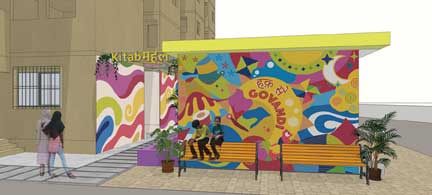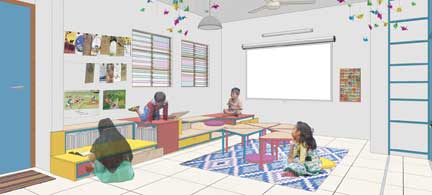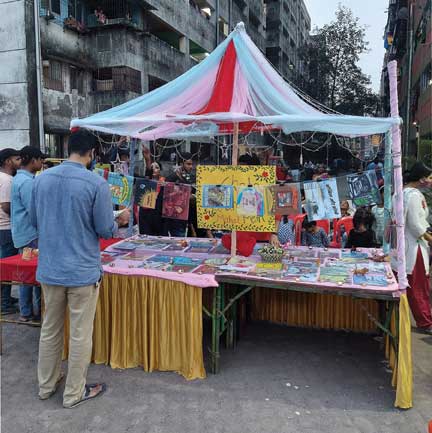Bhawna Jaimini
“Can I help you with holding the measuring tape?” We looked up to the boy who offered to help as we were busy taking measurements of the street in Natwar Parekh Colony, Govandi Mumbai, an eastern suburb. He looked like he was in his pre-teens with an effusive smile that drew us to him. Before we could ask him his name he disappeared after having helped us measure the street. I was disappointed to let him go without treating him to samosas – a speciality of the neighbourhood. We were back in the neighbourhood after a gap of nine months to pick up on multiple initiatives that were in motion before the pandemic hit.
We – a collective of architects, designers, artists and engineers – have been working to create spatial and social improvements in Natwar Parekh Colony – one of the many resettlement colonies built to house thousands of slum and pavement dwellers who were displaced to make way for ‘world class’ infrastructure. This has been both a dream and a nightmare. A dream because of the warm, accepting, driven, gifted and resilient people who inhabit one of the most un-habitable quarters of Mumbai and a nightmare because of the abject state of infrastructure, disastrous design and planning of housing and multiple bureaucratic loopholes that prevent any meaningful upgradation from happening in the neighbourhood.

When the pandemic came and took over our lives unannounced in March 2020, we were in the middle of planning and executing a number of initiatives – redesign a street for the elderly, creating a park for children, beautifying the streets with art – all of which came to an abrupt halt. The residents of Natwar Parekh Colony were some of the worst affected people during the pandemic, they suffered less from the disease but more from the lockdown and social distancing norms which took away their livelihood and confined them to their 225 square feet units – sometimes shared by more than 10 people. Even though we were not able to physically visit the neighbourhood, we were in close contact (thanks to Zoom!) with many of the residents and community organizers who were leading a number of relief efforts on the ground.
With trepidation and apprehensions, we found our way back into the neighbourhood early this year to pick up the pieces from where we left.
“Will the residents remember us?”
“Will they show up for community meetings?”
“Will they even care about working with us as they struggle to put food on the table?”
These were some of the many questions we deliberated upon before preparing to re-enter the neighbourhood, which was in a neglected state – physically, economically and socially. All the open and so called ‘public spaces’ were littered with garbage and sewage and residents reported a rise in thefts and cases of domestic abuse.

“Should we even bother them with all the ‘spatial’ and ‘public space’ talk while they are dealing with such fundamental issues in their lives?” Perhaps no, but as urban practitioners it was difficult to ignore the spatial injustice and its implications compounded due to the pandemic. How do we even begin to practice social distancing in a densely populated space like Natwar Parekh Colony, where more than 5000 people inhabit one hectare of land? Even with all the challenges that the community was facing, it felt imperative to continue working on spatial improvements in the colony.
Much to our surprise, the residents welcomed us with cups of chai and small helping hands to hold our measuring tapes as we began working again. The young boy with an effusive smile – Shoaib – who had disappeared that day without eating samosas with us came back again the next day. In the past five years of working in the neighbourhood, we have had limited interaction with children so we were very surprised to find Shoaib waiting for us every day at our local office. And with each passing day, more and more children followed us around as we tottered through the neighbourhood looking for neglected spaces that could be turned into warm, comforting public spaces for the residents.

It was baffling initially; what attracted the children to the work we were doing? But as we learnt more about Shoaib and his friends, everything started to make perfect sense.
Shoaib, 12, was enrolled in an Urdu medium school before COVID-19 started. His school wasn’t able to initiate digital classes and even if it had, Shoaib didn’t have a laptop or mobile phone to join. It had already been more than 10 months since Shoaib saw the inside of a classroom or picked up a book to read or write when we met him. It has now been more than 18 months since Shoaib stopped going to school. He also hadn’t left the periphery of Natwar Parekh Colony where he lives with his grandmother, his sole guardian and caretaker.
Shoaib is not an anomaly but the norm. Though a few children have been fortunate enough to be able to access education through their parents’ smartphones, we all know that staring into a small screen for six hours a day is no way to learn, grow, create, play or be. Interactions with Shoaib and his friends helped us articulate the need of having spaces for children where they can come together to interact with not just books but with each other – where they can feel safe yet challenged – and discover the world of books, beyond lessons and exams. What else can this place be, if not a library?
And thus, Kitaab Mahal came into being. Before beginning the designing process, we took the idea of creating a library to the children of Natwar Parekh Colony to know if they would warm up to the idea of being surrounded by books in the age of all things digital.
“We want a library! We want our Kitaab Mahal!” Their eyes beamed with excitement as they chanted in unison and we began building a place for joy, hope and reading.
The author is a writer and urban practitioner based in Mumbai. She works with the Community Design Agency, an architecture and design organization that collaborates with diverse communities in need to create sustainable change. She is deeply passionate about gender rights and believes in wearing her politics on her sleeve. She can be reached at bhawna@communitydesignagency.com.
